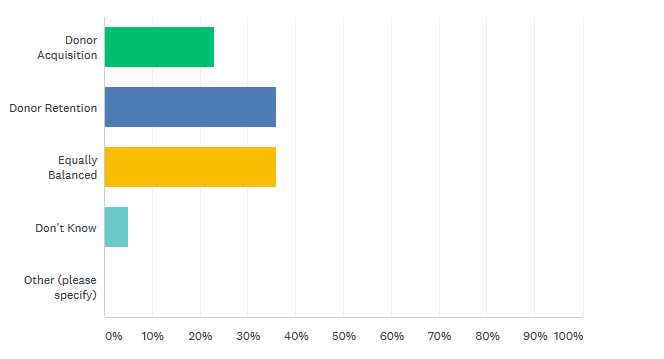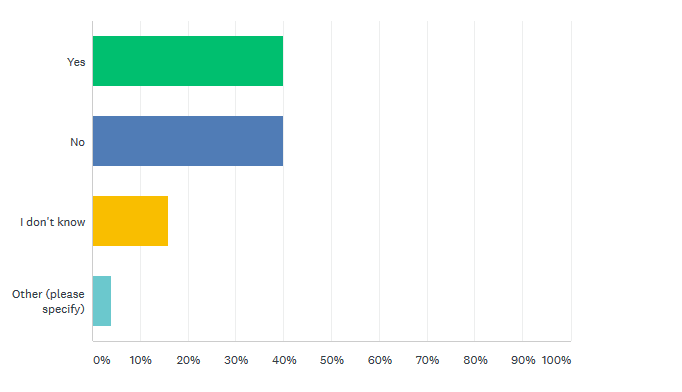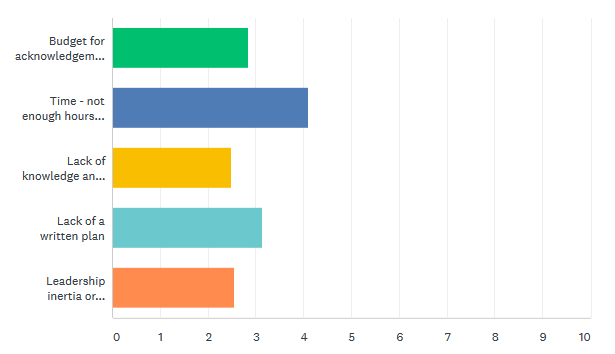
Which strategy makes you larger? Which one makes you small?
Wondering whether your colleagues at other nonprofits are prioritizing the same strategies as you are?
And if not, which one of you is headed down the right track?
And if you’re headed in a direction you know is wrong (or at least you have a hunch it’s not optimal), what holds you back from changing direction?
Sometimes we don’t take the time we should to pause, reflect and ponder.
And this can get us into a deep hole we didn’t even realize we started digging!
So, recently I asked the Clairification community:
What do you spend more time on? Asking or thanking?
I promised I would share the results, so here they are.
I’ll tell you what my thoughts are on the other side.
SURVEY RESULTS
Highest Priority Fundraising Strategies

Slightly more than one-third of organizations (36%) say they have a balanced strategy between retention and acquisition. An equal number of organizations prioritize retention. Almost a quarter (23%) prioritize acquisition. And a few (5%) just aren’t sure.
Satisfaction with Current Strategy Prioritization between Acquisition & Retention

About 20% were unsure whether they were happy or not with their current allocation of resources between acquisition and retention. The rest were equally divided: 40% were happy; 40% unhappy.
What Holds Organizations Back from Making Retention Higher Priority

As to what holds folks back, there are plenty of culprits. As I suspected, the number one reason organizations don’t make retention a higher priority is they can’t find sufficient hours in a day or sufficient staff to whom to assign tasks. In second place was lack of a written plan, followed closely by lack of budget and lack of knowledge and skills. Leadership inertia or apathy (failure to question the status quo) also scored a reasonably high response.
MY THOUGHTS
First, let me share some of the comments.
- Interestingly, some folks who’d not prioritized retention in the past were now in a place where they felt acquisition had to be their priority because their remaining cadre of donors were aging. While this is understandable, where will these folks be in the future if they continue to make retention a lower priority? Another pool of donors that dwindles as it ages?
- Others commented that the acknowledgement process takes too much time to ensure a quick turn-around. I completely understand, as I struggled with this myself when working in the trenches. It’s no excuse for offering a poor donor experience, however. What I did was convene an interdisciplinary committee (including everyone who touched the donor’s gift – online or offline – and acknowledgement letter or email) to figure out all the points of delay and then brainstorm solutions. We tightened up turn-around significantly as a result.
There’s always room for, and a pathway towards, improvement.
Please understand I’m not suggesting you stop trying to acquire new donors. I’m asking you to reconsider your priorities.
At the very least, there should be a balance. I would strongly argue, however, that retention should edge out acquisition. Because…
Until you’ve renewed someone, they’re not really a member of your family. They’re just a visitor.
By now you’re familiar with the “churn and burn” data. The Fundraising Effectiveness Project has been monitoring results for a decade, and retention is not improving. Last year, only 23% of first-time donors made a second gift. Donors? Or one-time visitors?
If you want donors who stand the test of time, you need a strategy where acquisition and retention go hand-in-hand.
Otherwise, you’re just wasting your time and money. You’re squandering your asks. You’ll lose your donor before you’ve even had time to make back what it cost you to acquire them.
Never acquire a donor until you also have a strategy for keeping that donor.
What’s your ‘next gift’ strategy?
Hopefully, it’s something beyond hoping they’ll give again next time you ask them. Because the data shows clearly that “hoping” doesn’t work. On average, less than half of all donors, first-time and ongoing combined, renew their giving. But this isn’t inevitable. I know organizations that renew 70% of their donors!
You have to take the bull by the horns.
Whether your donors stick with you, or not, is in your control.
First, you have to believe this! Do you? If not, why not? Because if you don’t believe you can keep folks loyal, you have a bigger problem. And that problem needs to be addressed first.
Do you love your organization? Believe you’re doing an amazing job? Think the world would be worse off were you to cease to exist? Good!
Help your donors share your beliefs by telling stories of impact and reporting on outcomes.
Figure out how to make donors feel like the heroes they are for contributing to your vital mission – beginning with immediately after they give, and continuing throughout the year.
What series of actions have you planned to woo your donor?
Your next gift strategy must be a series of actions that give your donor a transformational experience – something that makes their life better. Because donors don’t just make your mission possible; you make their mission (meaning; identity; self-worth) possible.
You see, donors are part and parcel of your mission.
Once you grasp that, and internalize it, donor retention becomes a snap. Because two things will happen:
- You’ll begin to live and breathe donor service, building goodwill and trust – which is the foundation of all sustainable relationships.
- You’ll begin to get to know your supporters and build a two-way relationship — wherein you’re able to meet donor needs and satisfy donor desires.
If you make a “stand out” retention plan, you’re likely to be perceived as “outstanding.”
In my last article I noted you can keep sending what you consider “good enough” or “polite” transactional acknowledgments, or you can choose to stand out. You can operate on the basis of checking one-time transactions off your list, or you can choose to dedicate yourself to offering a transformational, ongoing donor experience.
If you’re ready to make those choices – and to retain more donors over time – do this:
- Develop written “Donor Acknowledgement and Recognition Policies & Procedures.” Don’t do it alone. Convene a team – maybe even cross-disciplinary – and seek input and buy-in. Commit together to turning this document into an annual work plan. Decide how you’ll make sure you keep this operational, and hold folks’ feet to the fire.
- Assign responsibility for donor service. This can be either a dedicated staff member (e.g., “Donor Services Manager”) or responsibilities can be assigned as part and parcel of one or more staff members’ job descriptions. Based on years of experience, I can guarantee you if you don’t assign wooing your supporters as a responsibility, it will fall to the back burner.
- Create strategic work plans that enumerate everything you’ll do over the course of the year to draw your donor closer to you. Include measurable objectives and timeframes (who, what, when and where).
- Make sure there is a manager overseeing the plan and holding folks accountable. If you’re a one-person shop, ask your board or development committee chair to hold you accountable. This means talking about the importance of donor retention at board and development committee meetings. Avoid the trap of simply talking about how to find new donors. Who cares, if you can’t keep them?
A successful fundraiser combines “getting” with “keeping” strategies.
I’ll keep saying this until I’m blue in the face: If you make thanking an afterthought… or relegate writing thank you copy to someone without demonstrated copywriting skills… or ignore the importance of creating donation thank you landing pages… or fail to prepare attentive, caring online acknowledgements… or neglect to make quick turn-around a priority… or fail to report back on positive outcomes over the course of the year… then you’re essentially bidding your hard-won donors farewell. No nonprofit is too small, or too large, to make donor retention a higher priority. Whatever your size, you can grow and sustain a base of support.
Take a look at your donor retention rates. Are they average or above average? [Look to the Fundraising Effectiveness Project or Fundraising Report Card for guidance.]
I’ll bet you can improve your results! And guess what? You’ll deserve serious bragging rights. This is bottom line stuff. Dr. Adrian Sargeant’s work shows just a 10% increase in retention can yield up to a 200% increase in the lifetime value of your donor base. That’s BIG! Take my bet – and let me know how it worked out.
Want to Learn More about Winning Nonprofit Thank You Strategies?
Enroll in Clairification School and get instant access to 12 Nonprofit Thank You Mistakes to Avoid – a jam-packed webinar with 60 minutes of content and 15 minutes of Q & A.
- How to thank promptly
- How to thank personally
- How to thank meaningfully
- How to establish trust
- How to establish connection
- How to set yourself up for your next gift
- How to infuse gratitude into your daily modus operandi
Already seen that one? Thanks for joining me! As a Clairification School student you’ll get access to ALL of my recorded webinars and podcasts!
Your Clairification School membership lasts a full year. For just a small fee, you’ll have access to every single one of my articles, all of my recorded materials, bonus gifts, a personal dashboard with monthly tips and a discussion forum, and generous discounts on all my courses and e-guides.
This is an investment I promise you’ll be happy with – or your money back. But don’t just take my word for it.
I am convinced Claire Axelrad is the smartest person in fundraising. Her articles are impeccably researched, deeply thoughtful, and invariably useful to me. Thank you, Claire.
-Tom Ahern, Ahern Donor CommunicationsYou have a unique voice in the area of how nonprofits attract and retain donors. I am a huge fan of your writing!
– Ronald Pruitt, Founder, 4aGoodCause
Your material is always thoughtful and realistic. Thank you for your candor and good advice, we have no shortage of fundraising experts who publish regularly, but you are one of the few that I read faithfully.
— Richard Ajulani, Senior Director of Individual Giving, LifeMoves
I have been in the development world for 25 years and always find ideas I can use in your writing. Thanks for doing such a great job and keep ’em coming in the future!
–Kathleen Pasley, Director of Development, Dacor Bacon
Everybody involved in philanthropy should read this article slowly, with an opened mind and willingness to take from it the necessary components to change the manner and techniques we presently use in order to embrace what philanthropy is all about, “Love.” I have no doubt it would be transformational.
– Tom Walsh, Business Development Exec., Active Retirement Ireland
One of the best articles re marketing and fundraising that I‘ve read in a long time.
— Margot Harrigan. Director of Development. Community Health Awareness Council
I read your articles all the time and find your advice “spot on” and always usable. I pass it on consistently to the staff and other board members.
– Hal Leeds, Partner Global Sales & Marketing Consultancy, Working to Eliminate Poverty and Educational Inequality
I shared your article this morning with the President/Founder, and she is ON FIRE!!! She emailed all her staff and volunteers and told them this was the new vision.
– Cheryl Cuttineau, Pet Loss Support
Her blog is just a wealth of wisdom. What’s particularly notable about Clairification is that although the work is based on decades of past experience, Claire is always looking forward as well. She’s a great resource!
–Keith Heller, CEO, Heller Consulting
I’m subscribed to a million fundraising blogs and the one I consistently open and read most of, is yours. The content is always carefully curated and helpful, not just sales pitch after sales pitch for your own stuff. You stand out, in a good way.
—Juliane McLean, Development Coordinator, Bridgercare
What are you waiting for?
I have 35+ years’ experience in fundraising and nonprofit marketing – most of it in the trenches.
- I know your daily challenges.
- I’ve shared your frustrations.
- I know what works, what doesn’t, and why.
- I know how to make change happen.
I truly want to share my knowledge and expertise with as many folks as possible. And that’s why I founded Clairification and ‘Clairification School.’ I’m keeping tuition under $2/week (less than the price of a cup of coffee in most places, but enough to cover my overhead***).

Don’t miss a tip or insight. ENROLL TODAY!!!
***You do incorporate overhead costs into your fundraising asks, don’t you? If not, and you’re killing yourself running on a shoestring, please read What to Say When Your Donor Asks: How Much do you Spend on Overhead? It’s just one example of the types of articles you’ll receive from me – all year long.
I look forward to being your teacher, mentor, partner and friend.
Together, we’ll make our world a more generous and caring place.
Hope to see you soon!

P.S. If you ever have any questions, I’m just an email away. claire@clairification.com
Photo of a painting, taken by Claire Axelrad, as part of a series: The Art of Philanthropy – ‘Love of Humankind’ – as Seen Through the Prism of the World’s Art Museums (A High Five to those who recognized the “Surrealistic Pillow” album reference in the painting)


No organisation is so successful that being connected to their donors/supporters can stop being the most important thing that it does.